PLANNING OBJECTIVES… PROGRAMMING DECISIONS
Decisions about funding choices are critical to the future of the Navy. A dynamic, uncertain, but still-dangerous security environment competes with constrained defense resources to
create challenges and difficult tradeoffs in three major areas that, together, are the cornerstone for the 21st-century Navy:
| Force Readiness |
Force Structure |
Force Transformation |
The security environment has changed. The Navy is drawing upon the vitality and innovation of its people and leveraging new technological opportunities to create a transformation strategy
that will ensure tomorrow’s Navy can continue to meet its mission requirements and attain higher levels of operational effectiveness. While the recapitalization of resources is one possible solution to current funding concerns, a broader strategic context is essential if we are to avoid undue interim
risk. Today’s readiness must not suffer as we look to the future. This, alone, will demand the best, most enlightened stewardship of the Navy’s fiscal and physical resources.
The Navy will continue to develop new operational concepts that leverage current forces while exploiting our asymmetrical advantages and technological superiority. The Navy will continue to turn to industry and Commercial Off-The-Shelf (COTS) technologies and will privatize non-core functions when
feasible. Additionally, we will pursue solutions with other U.S. Armed Services and our allies.
Within this context of critical trade-offs and innovative solutions, broad planning objectives have been identified to guide our efforts to build the 21st-century Navy:
- Ensure that the minimum-essential force structure and core capabilities are preserved for naval, joint, and multi-national operations — for sustained forward-deployed presence, deterrence, prompt and assured crisis response, and warfighting — including fully integrating Navy and Marine Corps Reserve
components into a seamless Total Force
- Enhance readiness by providing a stable and rewarding quality of life for our people and their families by maintaining adequate pay, medical care, advancement potential, and benefits, and by providing a work environment that supports job satisfaction, including balanced sea-shore rotation
- Outsource and privatize non-core functions to industry whenever possible, thus reducing the size and cost of supporting infrastructure
- Leverage scarce resources through joint and international programs
These objectives are examined in more detail in the following sections.
21st Century Force Structure
The Navy’s force structure comprises the hardware — ships, aircraft, weapons, and systems — and, most importantly, highly skilled, motivated, and dedicated people required to operate and maintain it in active and reserve service. The 1997 Quadrennial Defense Review (QDR) addressed current and Projected force structure and force mixes within the contexts of strategy, operational concepts, and threats to U.S. interests. The force-structure outcomes of the QDR’s assessments are outlined below.
Force Mix Goals
Force structure requirements depend on the roles, missions, and tasks the Naval Services must perform. After careful and comprehensive assessments of current and future operational needs, the Navy is committed to sustaining a force structure including:
- 12 aircraft carrier battle groups
- 10 active and one reserve carrier air wings
- 12 amphibious ready groups
- 50 nuclear-powered attack submarines
- 14 nuclear-powered strategic ballistic missile submarines
armed with Trident II/D5 ballistic missiles and operated in two
oceans
- 116 surface warships — 108 in the active Fleet and eight in
the Naval Reserve Force
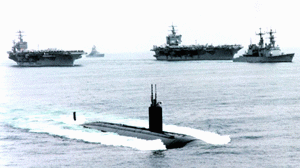
The number of nuclear-powered attack submarines provides a good
illustration of the planning challenges for tomorrow’s force
structure. A force of 50 SSNs in 2003 will allow on-average 11
SSN-years of deployments for the conduct of national missions,
theater tasks, and peacetime forward-presence operations
annually. This is compared to 16 SSN-years in 1998. (Figure 3 [use "back" key to return here] shows the decline in U.S. SSN force levels since the early
1990s, and projections to 2015.) The submarine force is entering
an asset-limited period rather than the requirements-driven
environment of the past. The choice is stark: Either the number
of available submarines must increase, or the days-at-sea goals
will almost certainly be exceeded, creating even more challenges
for the stewardship of the Navy’s people and their equipment.
This relationship is inescapable. Although a 1991 Joint Chiefs
of Staff submarine force-level assessment concluded that some
67-71 SSNs were needed to meet likely peacetime and projected
crisis-response, submarine force levels are again being
addressed in light of emerging requirements — routine
deployments, frequent contingency operations, and unplanned
operational commitments — for the mid- and long-term future.
Similar dynamics affect America’s aircraft carrier force. The
unparalleled combat power of the Navy’s aircraft carriers and
their multi-mission air wings provides the President with a wide
range of options for quick and effective response to crisis or
conflict, making them a critical component in America’s national
security and military strategies. But to ensure America’s
strategies are successful in these operations, sufficient
numbers of aircraft carriers must be sustained to meet
operational requirements without over-burdening the Navy’s
Sailors or their ships, aircraft, and equipment.
Real-world operational experience during the 1990s and numerous
studies have confirmed that a force of 15 carriers is needed to
satisfy the requirement for full-time carrier presence in
critical world regions. That force level, however, is simply
unaffordable in today’s and future fiscal environments, and the
Navy has determined that 12 aircraft carriers enable presence
and war-fighting needs to be met at an acceptable level of risk.
Fewer than 12 carriers, and operational needs go unmet or we
over-tax our people and forces. (Figure 4 [use "back" key to return here] shows the Navy’s plan
for sustaining the 12-carrier force objective.)
Likewise, the Navy’s multi-mission surface warships are in
constant demand in peacetime and crisis. The 116 surface force
limit set by the QDR represents the minimum required to meet the
regional commanders’ operational requirements, especially in the
critical mission area of Strike Warfare, where the Tomahawk
missile has become the “weapon of choice” in recent military
operations. Furthermore, given just 12 aircraft carriers, more
and more of the day-to-day presence requirements are being
levied on the Surface Force. For these reasons, the Surface Navy
has commissioned a surface combatant force level study to
reassess future needs. This situation has also generated a
highly innovative proposal for a “National Fleet” comprising
Navy and Coast Guard surface warships and major cutters.
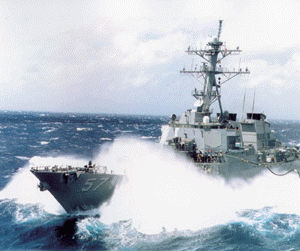
For these reasons, the QDR force levels and mixes are the
minimum essential force to satisfy the needs of America’s
security and military strategies. They serve as the foundation
for meeting today’s commitments as the Navy continues its
transformation for 21st-century operations. Although the
President has directed the Defense Depart ment to allocate
additional resources in real, after-inflation terms throughout
the FY 2000-2005 Future Years Defense Plan (FYDP), and the Navy
has restructured its FY 2000 FYDP shipbuilding program, it must
soon be increased further and sustained well into the future to
meet the long-term needs of the nation. By the middle of the
next decade, we must craft and support a long-term building
program of approximately ten new-construction warships per year.
A commitment to adequate and stable funding of such a program
will help to ensure that we do not over-burden our Sailors and
their families and that we can introduce the modern ships,
sensors, and weapons that will protect America’s interests and
friends throughout the world.
The Navy’s People
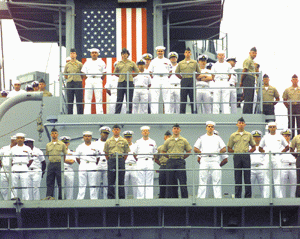
Since the end of the 1991 Persian Gulf War, Navy active duty end
strength has been cut by almost 188,900 officer and enlisted
personnel — a 33% reduction through FY 1998. (Figure 5 [use "back" key to return here] shows
this and other force structure trends.) By the end of FY 2003,
the drawdown will largely be complete, including implementation
of the Quadrennial Defense Review’s recommendation for
reductions of another 18,000 active-duty personnel. (The Navy’s
civilian work force has similarly been restructured, and the QDR
called for additional cuts of 8,400 civilian jobs.) Only 15% of
the total end-strength reduction between FY 1992 and FY 2003
will have come from funded force-shaping tools such as the exit
bonus program — Voluntary Separation Incentive (VSI) and
Selective Separation Bonus (SSB) — and the Temporary Early
Retirement Authorization (TERA). Another 2% will have come from
the Selective Early Retirement (SER) of officers and enlisted
with more than 20 years of service. Because the Navy stood fast
in its commitment to avoid an involuntary Reduction in Force
(RIF), the vast majority of the drawdown was accomplished
through typical personnel behavior such as regular retirements,
end of contractual obligations, and attrition-related losses.

Despite the drawdown, the Navy continues to hire, and achieving
recruitment goals is critical for the future readiness of the
Fleet. The Navy’s transition to a steady-state force with the
desired skill and experience mix in the active-duty component
has been a significant challenge. Maintaining a stable end-
strength target, fine-tuning force profiles, and improving
retention will require increased officer and enlisted retention
incentives (such as special pays and bonuses) and training
support for higher officer and enlisted accession requirements.
Large groups of both officer and enlisted personnel will reach
retirement eligibility during the next several years.
Additionally, smaller accession-groups will be reaching their
first career decision point. A stable end strength in FY 2003
and beyond means that every single loss, either planned or
unplanned, will have to be replaced by an offsetting gain to the
active duty force.
Naval Reserve Contributions
Consistent with the measurable trend that has characterized the
1990s, the Naval Reserve continues to be relied upon in ever-
greater ways. Twenty percent of the Navy’s uniformed personnel
are in the Naval Reserve. The increased professionalism of the
Reserve Force, flexibility, and the needs of the Fleet have been
the primary driving forces in this transformation of the Naval
Reserve in helping to meet the daily peacetime, crisis, and
wartime needs of America.
Although a small portion of overall Naval Reserve, one area that
clearly demonstrates the increased reliance the Navy has on its
Reserve is the use of Reserve Flag Officers for many full-time
Flag leadership positions throughout the Navy. During FY 1998,
nine Naval Reserve Flag Officers filled critical leadership
positions. Also, the flexibility of the Reserve team was best
demonstrated by our Naval Reserve C-9 transport aircraft
detachment in the Mediterranean, which delivered 50 Fast-Action
Security Team (FAST) Marines to Dar Es Salem, Tanzania, within
20 hours after the terrorist bombings of our two embassies in
Africa. These were the first U.S. military personnel to arrive
in-country after the embassy bombings. A macro-level indicator
is the total amount of contributory support the Naval Reserve
has provided for the Active Fleet in FY 1998 — some 2.3 million
work days of direct mission support. This represents more than a
100% increase since 1991, despite a corresponding 40% decrease
in reserve personnel.
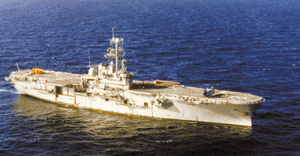
Naval Reservists are found in virtually every area in the Navy.
In fact, many critical mission areas are 100% covered by
Reservists. Those areas are: fleet air logistics, harbor defense
and mobile inshore-undersea warfare units, adversary fighter
aircraft, and naval control of merchant shipping. Also, many
mission areas have most of their capability in the Reserve,
including construction battalions, cargo handling, and military
sealift personnel. (Figure 6 [use "back" key to return here] shows the percentages of these and other Naval Reserve contributions to essential Navy capabilities.)
Approximately 70% of Naval Reservists are assigned to augment
active “gaining commands,” to which they provide additional
wartime manning and capability, as well as a peacetime
contributory support. Almost all major areas within the Navy
have augmenting Reservists. The remaining 30% of Naval
Reservists are assigned to stand-alone commissioned units. These
units include 26 ships, 35 aircraft squadrons, construction
battalions, mobile inshore-undersea warfare units, fleet
hospitals and cargo handling battalions. In all cases, these
augmented and commissioned units receive their funding from
resource sponsors which are responsible for funding active
programs as well.
Moreover, Naval Reservists are no longer “tied” to the
continental United States to perform their services. For
example, half of the Naval Reserve Force Oliver Hazard Perry
(FFG-7)-class guided missile frigates deployed last year for
more than four months, to operations such as CARAT and counter-
drug operations. This trend will continue into the near term
future years.
As a result of the QDR, the Naval Reserve will be restructured,
resulting in a reduction of 4,100 people. While some additional
reserve personnel will be required to support the transition of
Combat Logistics Force (CLF) ships to the Military Sealift
Command (MSC), other reserve positions will be eliminated as a
result of the accelerated reduction of surface combatants and
submarine tenders as well as the early withdrawal of the SH-2
helicopter from service. Additionally, the Navy has recommended
reductions in overseas activities that will decrease the
requirements for reservists assigned to base support. All said,
however, the seamless integration of Navy active and reserve
forces is no longer a distant concept, but an immediate reality
unmatched in any other service. In 1999, the Naval Reserve is an
active partner and full participant in the Navy’s worldwide
operations, and the Naval Reservist of tomorrow will be a truly
indispensable part of the 21st-century Navy.
Preserving Core Capabilities
While maximizing return on our long-term investment, America’s
naval expeditionary force structure must reflect enduring
requirements for forward-deployed operations and the emerging
naval strategic vision and operational concept for the 21st
century. New threats to shore-based forces and novel operational
maneuver concepts for joint operations will expand the Navy’s
requirements in four significant ways:
- The success of sea-based operational maneuver warfare will, in
part, depend on the ability of naval forces to establish and
maintain information superiority. The critical C4ISR
architecture and systems-capabilities for the campaign ashore
are increasingly likely to be provided by forces afloat.
- The spread of weapons of mass destruction and the means to
deliver them has made it more dangerous to concentrate our
forces — or their combat support — in easily targeted, fixed
areas. This places a premium on using agile, mobile, dispersed
forces ashore and supporting them “on-call” from the sea. It
also creates the need for naval forces to provide protection —
for example, theater air and ballistic missile defense — for
joint and allied forces ashore.
- Precision fire support — including long-range naval fires and
missile strikes — must be provided by forward-deployed naval
forces for amphibious ground maneuver units as they go ashore
and carry out their missions, as well as to support land-based
ground forces once introduced in-theater.
- Likewise, once forces are deployed to a crisis or conflict,
they must be sustained in-theater, and the success of future
operations will hinge upon the Navy’s ability to provide all
elements of logistics support. Innovative at-sea basing and
logistics-support concepts and capabilities will be needed if
similarly innovative operational maneuver concepts are to bear
fruit.
Naval expeditionary forces provide a host of essential
capabilities to the joint commander. Broadly, these fall into
four categories: Network-Centric Warfare, Sea and Area Control,
Power Projection, and Force Deployment and Sustainment.
Information Technology for Network-Centric Warfare
Information Technology for the 21st Century (IT21) is the Navy’s
overarching concept for achieving revolutionary, force-wide
information superiority and enabling robust operational
capabilities. Central to every aspect of the Navy’s continued
operational primacy, IT21 derives its power from the robust and
reliable networking of a force with diverse and distributed
capabilities. By tying sensors, shooters, and commanders
together in a shared information scheme, IT21 raises operational
potential to a new level. This scheme makes our forces smarter,
smoother, and more responsive through shared situational
awareness, increased collaboration, closer coordination, and
faster operational processes.
The IT21 scheme is often viewed in levels of information usage
or grids: Network-Centric Warfare, which encompasses Tracking
and Control, Coherent Tactical Picture, and Common Operational
Picture; and Navy-Wide Intranet. IT21 provides the information
backbone and Intranet that allows information sharing among all
afloat and ashore users. As first steps toward meeting these
requirements, the Navy has begun fielding several C4I programs.
The Global Command and Control System — Maritime (GCCS-M)
program provides for the common operational picture and
collaborative planning in the near term. Link 16 provides a
portion of the Coherent Tactical Picture. Cooperative Engagement
Capability (CEC) for air and missile defense and the Naval
Surface Fire Control System (NSFCS) for naval surface fire
attacks provide portions of the target tracking and weapon
control grid.
IT21 is a vital first step toward implementation of Network-
Centric Warfare. The information systems backplane provides the
warfighter critical end-to-end capability that extends from
personal computers (PCs) on local area network (LAN) segments
connected to wide area networks (WAN) and key ship-to-shore
interface sites. These ship-to-shore sites will provide the
critical information system management functions. The
centralized core of IT expertise that will reside at these sites
and other Information Technology Service Centers will provide a
comprehensive Information Management/Information Technology
support infrastructure. Other backplane components such as the
shore gateways, space segments, and network security systems are
essential for providing the PC-to-PC connectivity (End-to-End)
requirement for users located anywhere on the globe.
This revolutionary implementation strategy embraced under IT21
should fundamentally change the process of warfighting by
leveraging the use of IT as a force multiplier. Without the IT21
Information Backplane, Network-Centric Warfare cannot occur.
IT21 is important to the Navy because it enhances information
superiority for combat operations and reduces work force
requirements. Information superiority is achieved on several
fronts. Effectiveness of command is improved by transferring
comprehensive operational, intelligence, and logistics
information to the right place at the right time via protected
pathways. As a result, the implementation cycles for commanders’
directives are accelerated, gaining operational initiative over
an adversary and increasing probability of mission success. IT21
portends notable savings in work force accounts by modernizing
methods in which information is accessed, processed, and
subsequently disseminated in support of mission execution. This
enables ashore and afloat manning reductions, while other
benefits realized with IT21 implementation (e-mail, Direct TV,
and Sailor Phone) greatly improve quality of life and morale for
our deployed people.
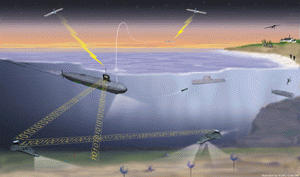
The Navy has already achieved significant success in harnessing
available commercial technologies and systems for naval use.
Ships and aircraft equipped with the Joint Tactical Information
Distribution System (JTIDS) and its follow-on Multi-functional
Information Distribu tion System (MIDS) have the capability to
receive and distribute near-real-time tactical data. The Global
Command and Control System-Maritime (GCCS-M), formerly called
the Joint Maritime Command Information System (JMCIS), is the
cornerstone of the Navy’s afloat command-and-control programs
and is the maritime version of the Defense-wide Global Command
and Control System (GCCS). This system can process sensor
information and communications for all warfare mission areas. It
supports all levels of command and can be integrated with other
services systems and remain interoperable with those of our
allies, as well.
The Navy’s revolutionary “Ring of Fire” concept for naval fire
support coordination is a perfect example of NCW, linking a wide
variety of platforms — aircraft, surface ships, and submarines
— into a single battle group LAN. Ring of Fire automatically
matches requests for fire with available assets, saving both
manpower and time, while ensuring the correct ordnance is on
target when and where needed. In 1997, for example, the U.S.
Third Fleet successfully tested an early prototype of the Ring
of Fire during Fleet Battle Experiment (FBE) Alpha, held in
conjunction with the Marine Corps Hunter Warrior Advanced
Warfighting Experiment. In FBE Bravo, later in 1997, the Third
Fleet expanded the concept to include tactical aircraft and
land-based Marine artillery units. Bravo also demonstrated the
Ring’s ability to receive data from external sources, such as
Air Force Joint STARS surveillance aircraft. Fleet Battle
Experiments continue at an approximate rate of two per year,
with continued focus on developing network-centric capabilities,
increasingly in forward-area Joint operational environments.
The first such forward-area experiment, FBE Delta, was conducted
in conjunction with Foal Eagle ‘98, a joint and combined theater
exercise, during October and November 1998. The Delta
experiments include the most
futuristic test yet of theater combined-arms coordination, using
E-2C Hawkeye airborne early warning aircraft, nuclear
submarines, surface warships, Special Operations Forces (SOF),
and Air Force F-16 Fighting Falcon aircraft to address specific
theater concerns: counter-SOF, counter-fire, and joint theater
air defense. In FBE Echo, scheduled for March-April 1999, the
Navy and Marine Corps will explore further naval operations in
the urban environment, including netted naval sensors and fires,
command and control, and theater air defense. FBE Echo will also
address several entirely new concepts for undersea warfare to
deal with the anticipated full range of asymmetric maritime
threats.
The Navy is advancing its NCW ability by improving its
technologies and doctrine to support Information Warfare (IW).
This allows disruption, neutralization, and deception of enemy
forces, while providing friendly forces with superior
intelligence and robust defenses against an adversary’s own IW
systems — all in support of Joint Vision 2010’s concept of
information superiority.
When fully developed, NCW will provide naval forces with
superior understanding of complex operations and the means to
collaborate better and coordinate more closely. The commander is
more in tune with key details of the ongoing operation.
Commanders and their forces share an accurate, timely awareness
of the operational situation. Superior knowledge and
coordination are fundamental force multipliers, which when
coupled with certain capabilities can create quantum leaps in
operational effects. The emergence of NCW permits the
complementary evolution of new capabilities and the improvement
of existing capabilities of enduring value.
Sea & Area Control
Only a few major powers will have the capability to provide a
sustained, long-range threat to maritime supremacy and thereby
challenge the Navy’s concept of dominant maneuver from the sea.
That said, future adversaries unable to match U.S. military
power head-on may attempt to intimidate our regional allies and
friends before the full weight of U.S. power can be brought to
bear, in an attempt to delay or deny our access to critical
areas of operations. Indeed, they may seek to block the
projection of U.S. military power into crisis areas by attacking
the ports, key logistics hubs, and airfields necessary for
operations by land-based forces; concentrations of U.S. and
allied forces; and ships and aircraft in transit to the areas.
Both conventional and WMD attacks could well come from
individual terrorists or a broad spectrum of land, sea, and air
area-denial forces.
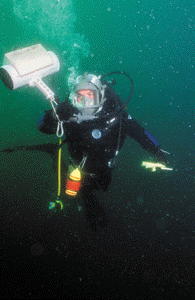
Nevertheless, even regional adversaries could make the
investments necessary to extend the range of their area-denial
forces out to sea, beyond the chaos of the littorals, by relying
on a mix of dispersed sensors and various weapons platforms,
including submarines and long-range air power. Such scenarios
envision an adversary’s reliance upon asymmetric warfare to
inflict a disproportionate injury against a U.S. capability or
friend, in the expectation that U.S. leaders may make a
political decision not to proceed. The threat of naval mines in
the 1991 Persian Gulf War provides a good example of one such
scenario. Two U.S. warships, the USS Princeton (CG-59) and USS
Tripoli (LPH-10), suffered mine-strikes on the same day. The two
ships sustained more than $125 million in damage, with several
crew-members injured. Princeton was essentially taken out of
action for repairs. Had either or both been sunk with a
significant loss of life, the domestic U.S. public reaction
might have had a similarly significant political affect on
subsequent military decisions, despite our overwhelming
superiority. As it was, the presence of more than 1,300 Iraqi
naval mines and surf-zone obstacles served to constrain the
multi-national coalition’s operational alternatives in the
northern Arabian Gulf.
The ability to dominate sea and air lanes and then to defeat an
adversary’s sea, littoral, and air capabilities throughout a
broad theater of operations will be a fundamental naval strength
that undergirds a credible U.S. forward presence. The increasing
reach and lethality of area-denial threats will require that
America’s naval expeditionary forces be fully capable of
establishing control against sophisticated opposition at sea,
ashore, and in the information realm.
Sea and area control are thus prerequisites for theater
battlespace dominance — the heart of naval warfare — and are
essential elements of the naval expeditionary mission.
Throughout its history, the Navy-Marine Corps Team has excelled
in establishing sea control and dominating the littoral
battlespace. This has entailed blue-water operations against an
opposing force, as well as clearing mines and suppressing shore
defenses. Navy and Marine Corps forces deny access to a regional
adversary, interdict the movement of its supplies, and control
the littoral sea and air space. In the near future, naval forces
will also be able to establish theater-level command and control
and to spearhead joint efforts to defeat hostile air, cruise,
and ballistic missile threats. The Navy will ensure that
reinforcement and resupply reach naval expeditionary forces
ashore and follow-on heavy land-based ground and air forces. As
innovative operational concepts evolve in response to the
reality of regional and possible global threats, ground force
operational and logistics support will increasingly be sea-
based. That will be possible only if U.S. naval forces control
the maritime and littoral battlespace.
Together, these forces can control an area extending from the
open ocean to the shore and inland to that area that can be
directly supported and defended from the sea. Aircraft carriers
and their multipurpose air wings, submarines and surface
warships, amphibious forces, and supporting naval forces are the
backbone of the U.S. military’s ability to dominate regional and
littoral battlespaces, which is the sine qua non of the nation’s
ability to project credible military power from the sea.
Power Projection
Power projection requires agility, mobility, flexibility, and
technology to project strength against weakness. The Navy
accomplishes this through implementing innovative littoral and
amphibious maneuver warfare strategies, doctrines, and
operational concepts, and using all available capabilities and
assets, including:
Aircraft carriers and sea-based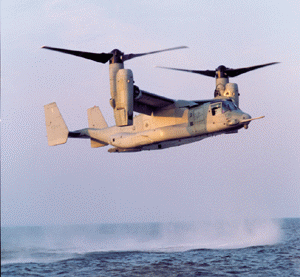 tactical air-power to strike
at critical targets and to support directly ground forces ashore
tactical air-power to strike
at critical targets and to support directly ground forces ashore
Surface warships to provide precision land-attack with
responsive, lethal naval “fires” in conjunction with missile
strikes and multi-layered air defense against aircraft, cruise
missiles, and ballistic missiles on both an area- and theater-
wide basis
Nuclear-powered submarines to provide covert intelligence,
surveillance, and indications and warning; to land and recover
SOF troops; and to launch surprise, long-range tactical missile
attacks
Marine Expeditionary Forces (MEF) operating from amphibious
assault ships to enable follow-on entry of heavy land-based air
and ground forces — should they be needed
Naval Construction Battalions (Seabees) and the Marine Corps’
Expeditionary Combat Service Support (CSS) assets to support
forces operating ashore
The nation’s naval expeditionary forces can project decisive
military power from the sea, in the face of even the most
determined adversary. Precision operations conducted from
surface warships, attack submarines, and carrier-based aircraft
will provide massive, sustainable fires from the sea. Naval
forces can generate high-intensity offensive power and Marines
can quickly achieve critical objectives to enable the follow-on
introduction of U.S. and allied forces. Joint operations, using
both Navy and Air Force strike assets, are becoming a standard
means of rapidly delivering significant firepower to remote
targets, such as the joint Desert Strike operation in September
1996 and Desert Fox two years later.
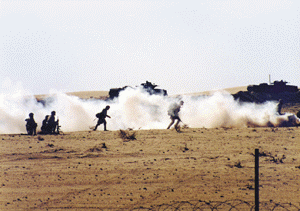
In the early years of the next century, the Navy-Marine Corps
Team will be able to project sea power in a way that Alfred
Thayer Mahan, the late-19th century naval strategist and
historian, could not even imagine. For example, designed from
the keel up with the land-attack mission in mind, the 21st-
century Land Attack Destroyer (DD-21) is a revolutionary
approach to warship development. DD-21 will be the first fully
integrated ship with warfighting, control, and maintainability
supported by a single, open-architecture computer operating
environment. The integration of joint C4ISR systems will permit
DD-21 to maintain the real-time joint tactical picture needed to
respond to calls for fire — long-range, gun-launched guided
munitions and land-attack missiles —from troops ashore in a
timely and accurate manner, far beyond what is capable today.
Advanced joint and national information and targeting systems
will multiply the impact of the Naval Services’ long reach —
some 80% of the world’s population centers can today be the
focus of naval “littoral” operations — and enable us to mass
the effects of distributed but precise fires from the sea
wherever they will have the greatest influence on events ashore.
A new dimension of sea power will result in naval campaigns that
combine highly mobile Marine operations deep into the littoral
with responsive close air and fire support and long-range
precision strikes. This focused, precise firepower will be
sustained entirely from the sea, fully supported by advanced
sea-basing concepts and platforms — accomplishing the effects
of massed firepower without the need to mass forces physically.
Force Deployment & Sustainment
The Navy’s ability to move and sustain U.S. forces overseas by
strategic sealift is another unique role. Equipment, ordnance,
and supplies needed to conduct any sizable projection of joint
military power must move by sea. During the 1990-1991 Gulf War,
nearly 95% of all material, supplies, and equipment sent to the
combat theater — and returned to the United States once peace
was restored — was carried in ships. Sealift is vital to Army
and Air Force regional operations, as these services are almost
totally dependent upon the “steel bridge” of sealift ships to
deliver everything a modern fighting force requires to
accomplish its missions. Similarly, the Marine Corps Assault
Follow-On Echelon (AFOE) is carried exclusively by sealift.
Forward-deployed and prepositioned ships continue to be an
essential alert force, constituting a valuable tool for
deterrence as well as for an initial ground assault. Follow-on
surge sealift ensures timely deployment of U.S.-based units,
while sealift sustainment forces will resupply deployed forces
for as long as needed.
The Navy’s ability to protect sea lanes and ports of
debarkation, and thus to ensure the unfettered flow of supplies
and equipment, is a critical factor in the success of an
expeditionary operation. As the number of U.S. bases overseas
continues to decline, reliance on sealift will expand
commensurably. The continued ability to move and sustain forces
in forward areas increasingly will be a critical gauge of the
Navy’s ability to meet joint overseas commitments.
Tomorrow’s Navy-Marine Corps Team will continue to be called
upon to sustain a meaningful presence in important world
regions. Force sustainment encompasses the comprehensive and
responsive logistic support system that includes air and
sealift, replenishment ships, mobile repair facilities, and
advanced logistics support hubs. This capability underpins the
Navy’s future ability to operate worldwide. Assets and
capabilities that provide the ability to move and sustain naval
and other U.S. forces at great distances from America’s shores
include:
- Combat Logistics Force (CLF) ships
- Strategic sealift ships and assets (both MSC and commercial
assets)
- Forward Logistic Support Sites (FLSS)
- Maritime Prepositioning Ships (MPS)
Under the Large Medium-Speed Roll-On/Roll-Off (LMSR) program,
the Navy is building or converting a total of 19 heavy sealift
ships, which will preposition Army heavy combat equipment in
forward areas and provide additional surge sealift capability in
time of crisis. The Navy is also pursuing the Maritime
Prepositioning 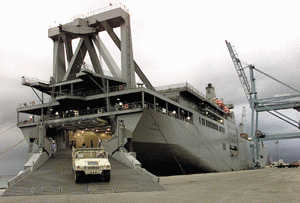 Force-Enhanced (MPF-E) program, which will add
two ships to the current force of 13 MPF ships.These ships will
expand the capabilities of the current Maritime Prepositioning
Squadrons, adding a fleet hospital, Seabee battalion assets,
expeditionary airfield, MEF headquarters, and additional
sustainment.
Force-Enhanced (MPF-E) program, which will add
two ships to the current force of 13 MPF ships.These ships will
expand the capabilities of the current Maritime Prepositioning
Squadrons, adding a fleet hospital, Seabee battalion assets,
expeditionary airfield, MEF headquarters, and additional
sustainment.
Through the National Defense Features Program, the Navy is
paying to install militarily useful features on commercially
owned and operated merchant ships. In return, ship operators
agree to make these ships immediately available for Defense
Department use in a contingency.
Nearly 100% of the Navy’s Expeditionary Logistic Support Force
(ELSF) resides in the Naval Reserve. This mission has been
successfully addressed with Naval Reservists, providing a highly
cost-effective and flexible capability. For example, Advance
Base Functional Component (ABFC) Units are capable of loading
and unloading equipment and material at ports of embarkation and
debarkation. Also, our Navy medium-airlift squadrons, which
reside completely within the Naval Reserve, provide all of the
Navy’s intra-theater airlift of critical supplies and personnel,
on an every-day basis. As we continue to “right-size” the Navy
for the current and likely future environment, the assignment of
much of this mission area within the Naval Reserve has allowed
us to maintain this critical capability in a most cost-effective
manner.
To evaluate new logistics concepts, the Navy and Marine Corps
created the Naval Logistics Wargame in 1994. The most recent
game, played in 1997, looked out to 2007 and emphasized support
for Operations Other Than War (OOTW) and multiple Smaller-Scale
Contingencies (SSCs), culminating in reconstituting and
redeploying forces from these operations to respond to a Major
Theater War (MTW). The wargame also assessed the emerging
Expeditionary Sea-Based Logistics concept and the Focused
Logistics concept from Joint Vision 2010. As part of the Joint
Vision 2010 process, the Naval Logistics Wargame has now evolved
into the joint Focused Logistics Wargame (FLOW), which will be
played for the first time in 1999. The results of these and
future assessments and wargames will continue to shape the
Navy’s force-sustainment programs and initiatives.
Ensuring Quality of Life
The transformation of today’s Navy to meet the challenges of the
future will be accomplished by our Sailors. The Navy’s men and
women — with their deeply held values of honor, courage, and
commitment — will be the cornerstone of the Navy of the 21st
century. Faced with the demand for a leaner but more capable
Navy, we fully understand that we rely on the innovation and
dedication of our people to ensure that the Navy of tomorrow can
indeed meet the demands thrust upon it.
To that end, the Department of the Navy must attract, train, and
retain dedicated, career-minded men and women for the arduous
tasks ahead. The Navy’s Quality of Life programs have a direct
impact on the readiness of the Total Force and, as such, are
essential to the Navy’s mission. Thus, the Navy will continue to
request adequate funding to support several important
initiatives.
Health Care
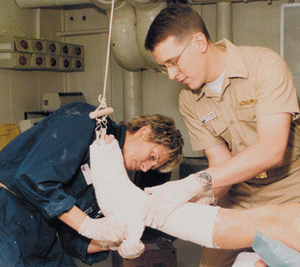
All Navy and Marine Corps families must be provided with quality
medical care. Managed-care initiatives have been extremely
successful at increasing access to care, ensuring the highest
quality, and managing costs. The Navy recognizes the commitment
its men and women make to serve our nation, and will continue to
support these and other Quality of Life programs to address
unique and compelling needs of service members and their
families. These programs provide a high return on investment and
contribute to preserving the readiness of the Navy’s Sailors to
meet the daunting professional and personal demands placed upon
them.
Educational Services
The Navy has redesigned its recruitment training program and is
taking an innovative approach to leadership training. From the
first day of boot camp, the Navy instills pride in the service’s
core values — honor, courage, and commitment — and builds the
warrior spirit in each recruit. To guarantee today’s recruits
become tomorrow’s leaders, the Navy has added a new Leadership
Training Curriculum program with eight structured blocks of
training. The courses are taught by Navy Sailors willing to make
a serious commitment to leadership training. The Navy is thus
laying the groundwork for every Sailor to make a difference and
take pride in his or her service to the nation.
The Navy also continues to support Voluntary Education fully,
recognizing that Sailors who improve themselves through further
schooling increase force readiness, in addition to enjoying more
productive and satisfying military careers. In recognition of
the role of voluntary continuing education, the Office of the
Secretary of Defense instituted a uniform tuition assistance
policy across the Armed Services on 1 October 1998. The Navy has
further demon strated its support for continuing education
through two major achievements:
- Thirteen new Academic Skills Learning Centers are being
established in FY 1999, bringing the worldwide total to 34. All
major Navy bases will have such a center by the year 2001.
- Every eligible Navy ship has an educational program under the
Program for Afloat College Education (PACE). PACE will be
sustained into the future.
Finally, the Navy is increasing educational opportunities with
the addition of upper-division and graduate-level courses.
Through its investment in educational technology, the service is
making it possible for every Sailor to continue advancing
academically, regardless of mission or duty location. An
educated Sailor is better able to meet the challenges of the
coming decades. Thus, the investment in this important Quality
of Life program is not only an investment in recruitment and
retention, but an investment in readiness as well.
Family Service Centers
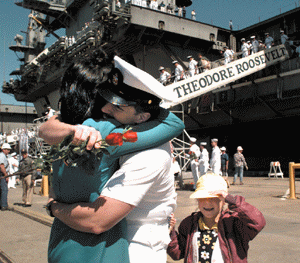
The Navy’s 62 Family Service Centers offer a variety of personal
support services to single and married Sailors and their
families. They provide proactive family support in improving
life skills and coping with inherent stresses of Navy life. By
providing information and referral services, education,
training, and counseling, these centers help prevent family
problems or minimize their impact, allowing service-members to
focus on assigned duties.
These centers also support the Family Advocacy Program, which
identifies, prevents, treats, and follows up on a wide range of
child and spouse abuse situations. New-Parent Support (NPS) is
our primary prevention program for child abuse, ensuring that
new parents get off to a safe and healthy start at naval
installations world wide. Today’s children will be tomorrow’s
Sailors. NPS services, including home visitation, are available
at more than 30 locations.
Bachelor & Family Housing
Through the Neighborhoods of Excellence Program, service-members
are provided with secure living environments comparable to
private communities. Additionally, housing allowances are
continuously reviewed to enable Sailors to own their own homes
or rent housing in safe and clean communities. Unmarried first
and second-class petty officers on sea duty are now eligible for
off-base housing allowances in many home ports.
The Basic Allowance for Quarters (BAQ) and the Variable Housing
Allowance (VHA) have been combined into a single, enhanced
housing allowance — the Basic Allowance for Housing (BAH). This
new allowance will be more accurate and responsive to every
Sailor’s needs. There is, as well, an extensive program in place
to upgrade government-owned quarters, concentrating on comfort,
security, and privacy.
Morale, Welfare & Recreation
The Navy Department’s Morale, Welfare, and Recreation (MWR)
programs focus their energies on meeting the fitness, leisure,
and community activity program needs of our Sailors and their
families. In addition, MWR serves reservists, retirees, and
civilian employees. Quality MWR activities make major
contributions to the mental, physical, and social well-being of
our entire Navy family and are fundamental elements in the
Navy’s efforts to maintain a ready force.
MWR offers a broad array of programs, ranging from basic
physical fitness and constructive off-duty recreation to family
support and personal development activities designed to meet the
needs of the Navy community. Fitness programs include afloat
activities as well as outdoor recreation events, such as rafting
and rock climbing. The explosive growth in information
technologies has also enabled the Navy to provide its forward-
deployed Sailors with e-mail and other direct links to their
families at home.
Family support programs primarily encompass youth and child
care. Child Care Programs are designed to meet the needs of the
Navy and Marine Corps work force by assisting working parents in
locating affordable, full-time child care. The school-age care
program works in conjunction with local school systems to
provide quality programs before and after school hours.
The school-age care
program works in conjunction with local school systems to
provide quality programs before and after school hours.
MWR programs enhance readiness by promoting teamwork, retention,
fitness, a positive mental outlook, improved morale, and a
healthy alternative to substance abuse. Surveys confirm a strong
correlation between the quality-of-life support MWR provides and
the Navy’s success in retaining a quality force.
Outsourcing Functions & Reducing Infrastructure
Consistent with the Vice President’s National Performance Review
and the results of the QDR, the Navy and Marine Corps continue
to pursue several important outsourcing initiatives that involve
privatizing non-core functions currently performed by Navy
Department civilian and military activities. Such outsourcing
will reduce infrastructure and produce savings that can be
allocated to critical readiness and recapitalization needs, as
well as to support current operations.
Efforts are continuing in Navy concentration areas to
consolidate or “regionalize” installation management
unctions. Regionalization reduces Base Operating Support (BOS)
costs through the elimination of unnecessary
management layers, duplicative overhead, and redundant
functions. Regionalization also facilitates better workforce
usage, development of most efficient organizations,
opportunities to conduct regional public/private competitions,
standardization of processes, interoperability, and regional
planning and prioritization.
In conjunction with regionalization, the Navy is also reducing
the number of its Major Claimants involved in the installation
management business. As regional installation management
organizations are created, BOS resources and responsibilities in
Navy concentration areas will transfer to a single major
claimant. Simultaneously, installation
management responsibilities will transfer from specific
claimants, permitting these claimants to concentrate on their
primary mission.
These important cost-reduction efforts are changing the
fundamental nature of installation management and support
service delivery. Regionalization and claimancy consolidation
provide Navy concentration areas a means to apply state-of-the-
market, best-business practices, employ broad-based competitive
sourcing and privatization studies, pursue regional business
process reengineering initiatives, and continue to provide
quality support at less cost.
The Navy’s FY 1998 Program Objective Memorandum (POM) identified
several key outsourcing and privatization initiatives that will
realize some $3 billion in savings through FY 2003, with another
$1.4 billion annual savings projected in FY 2004. These
initiatives continue to be pursued:
- Competing 80,500 full-time-equivalent jobs during the FY 1998
FYDP
- Creating the outsourcing support office to provide support and
tools to facilitate the process
- Applying competitive market tools in such areas as housing and
bachelor quarters, utilities, base libraries, harbor tug
operations, ship planning yards, and base operations at selected
sites
- Forming partnerships with private sector and local governments
It is imperative that the Navy properly balance the size and
cost of its support establishment relative to its operating
forces: a lean Navy “tail” must support a mean warfighting
“tooth.” The Navy is thus continually searching for new,
innovative, and less-expensive ways to keep our forces in top
readiness and supplied with the best equipment available.
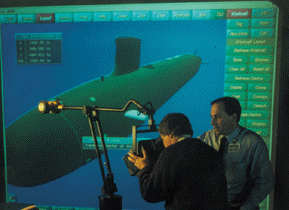
The commercial world has long been the primary source of defense
innovation. To make best use of this national resource, the Navy
is working to simplify its research, development, and
procurement processes through acquiring less-costly, easily
upgradable, commercial products. In so doing, the Navy will save
resources and obtain modern, “leading-edge-of-the-shelf”
equipment.
There will continue to be a requirement to test and evaluate
many weapons and platforms that are procured. To reduce
infrastructure and increase efficiency, the services have
increased the extent to which they share ranges and other test
facilities. The Naval Air Warfare Center maintains an Aircraft
Research, Development, Testing, and Evaluation (RDT&E) facility
at Patuxent River, Maryland; the weapons RDT&E facilities at
China Lake and Point Mugu, California; and the Undersea Warfare
Testing facility at Andros Island, The Bahamas. These facilities
comprise the Navy’s contribution to the Defense Department’s
Major Range Test Facility base.
As a result of the final deliberations of the Base Closure and
Realignment Commission (BRAC) in 1995, eight additional major
installations are scheduled for closure by 2001; the Navy will
ultimately close or realign a total of 178 bases. In 1999, 11
additional facilities will be added to the 162 closures or
realignments already completed.
To accommodate this and previous BRAC reductions in support
infrastructure, the Navy is closing bases and consolidating
maintenance facilities for aircraft, ships, and equipment into
regional activities, reducing the number of facilities and
operating costs while causing no reduction in readiness. Supply
support functions are being consolidated into regional Fleet and
Industrial Supply Centers (FISCs), which are assuming greater
responsibility for inventory management, contracting, and
hazardous material management. Some of these initiatives may
have sizable up-front costs, but long-term savings and benefits
will be significant and will go a long way in helping to
recapitalize the Navy’s operating forces. We anticipate
recurring savings of $2.6 billion per year after all 178 bases
are closed or realigned.
Nevertheless, reductions in the Navy’s infrastructure have not
kept pace with the reductions in force structure. While the
number of ships and Sailors were reduced by 40% and 30%,
respectively, since 1988, the Navy’s infrastructure decreased by
only 17%. Additional BRAC rounds are therefore critical for the
future readiness of the Navy.
The Navy thus continues to seek ways to streamline and reduce
the costs of shore infrastructure. The number of claimancies
that own shore bases has been reduced and consolidated in an
effort to reduce overhead without adversely affecting mission.
In addition to claimant consolidation, emphasis is being placed
on regionalization in fleet concentration areas to reduce the
cost of shore infrastructure. Through a newly instituted
regional planning initiative, redundant functions and base
operations will be identified and eliminated. Regional planning
is expected to include other Defense Department, federal, and
community agencies.


 Return to the Table of Contents
Return to the Table of Contents







 tactical air-power to strike
at critical targets and to support directly ground forces ashore
tactical air-power to strike
at critical targets and to support directly ground forces ashore
 Force-Enhanced (MPF-E) program, which will add
two ships to the current force of 13 MPF ships.These ships will
expand the capabilities of the current Maritime Prepositioning
Squadrons, adding a fleet hospital, Seabee battalion assets,
expeditionary airfield, MEF headquarters, and additional
sustainment.
Force-Enhanced (MPF-E) program, which will add
two ships to the current force of 13 MPF ships.These ships will
expand the capabilities of the current Maritime Prepositioning
Squadrons, adding a fleet hospital, Seabee battalion assets,
expeditionary airfield, MEF headquarters, and additional
sustainment.


 The school-age care
program works in conjunction with local school systems to
provide quality programs before and after school hours.
The school-age care
program works in conjunction with local school systems to
provide quality programs before and after school hours.



